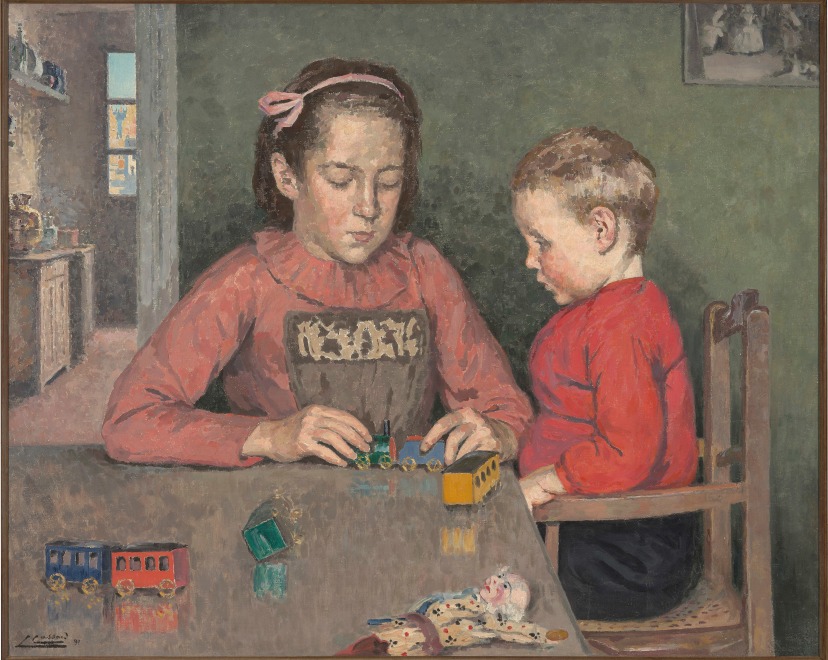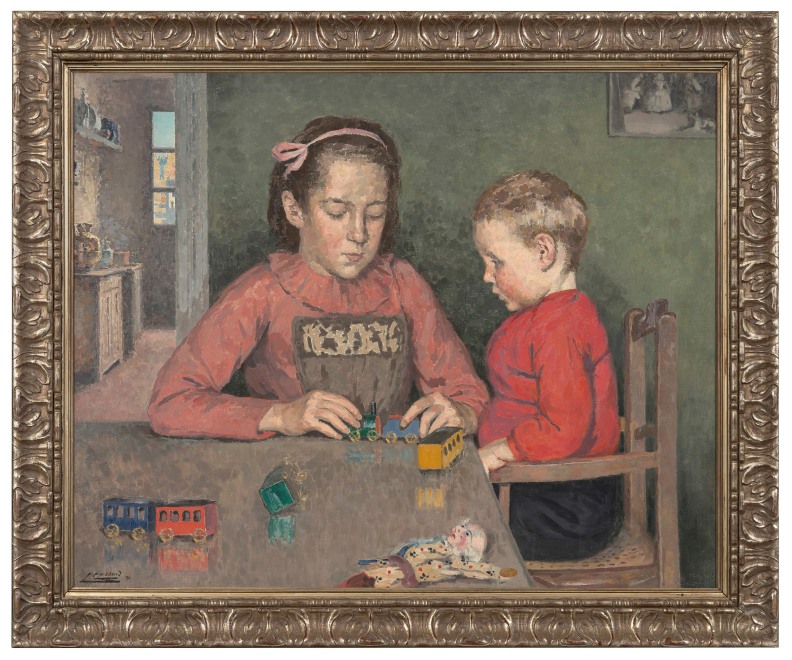Provenance
Private collection, Paris
Exhibited
Possibly Paris, Salon de la Société nationale des Beaux-Arts, 1894, no., 213 as Le coin des petits enfants
Literature
« Avant le Salon, » L'art français: revue artistique hebdomadaire, Volume 7, no. 361, 24 mars 1894, np.Catalogue note
Painted in 1891, our painting depicts two children, most likely a sister and brother playing around a kitchen table topped with a train set and a Punchinello puppet. The colorful toys contrast with the gray-green and beige tones that dominate the rustic interior of the room. The little boy in his bright red pullover is a focal point of the composition. He intently observes his sister demonstrating how the miniature train cars can be attached to form a convoy. Maybe the young girl has been put in charge of her baby brother and has figured out a way to keep him occupied and therefore well-behaved. A loftier interpretation of the scene could symbolize the general theme of education comprising the following predicates: learning by example and teaching; in other words, the beginnings of the harmonious development of every human being. Paintings of children had become popular subjects in the second half of the 19th century. The most recurring images depict them in group settings, often in a classroom or a schoolyard or frolicking outdoors. Cassard chose instead to focus on a more intimate scene of childhood, where what at first appears as a playful game, also becomes a learning activity.
Judging from the simple kitchen interior and the plain clothes of the children, Cassard has chosen to depict a working-class family, the types he would have seen in Le Cellier. However, one detail in this utilitarian room specifically stands out: the grisaille image in the upper right corner of the painting is a reproduction of Velázquez’s Las Meninas, Cassard’s discreet tribute to one of the great masters of western painting. In addition, the layout of the interior with the view into the kitchen followed by a glimpse of the outside through a window recalls yet another old master painter, Pieter de Hooch. There had been a revival of interest in Dutch seventeenth century painting in France in the mid-19th century in large part due to the publications from 1858 and 1860 by the art critic, Théophile Thoré, who had also been responsible for the rediscovery of Vermeer at this time.
Although a student of William Bouguereau in the early 1880s, Cassard’s subsequent style and technique evolved in a different and more modern direction. Like many artists of his generation, Cassard was influenced by the neo-impressionist painters, Seurat and Signac, who espoused a new style that we now know as Pointillism. While not as distinct as Seurat’s “scientific” pointillism consisting of small dots of contrasting colors, Cassard sought to emulate Seurat’s technique by modulating his colors through active brushwork that provides greater flexibility between shadows and light, while avoiding the flat aspect of academic painting. Even the faces of the children are defined by the same technique in the various shades of their flesh tones.




